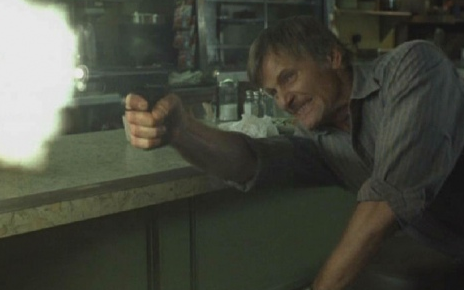Here is one of those peculiar occurrences that happen maybe once or twice a year for me, when I respond so strongly to a film that I feel the need to restrain myself. I mean, this is not Ain’t It Cool News, I can’t just go, THIS MOVIE KICKS ASS!!!!! VIGGO IS TOTALLY BADASS!!!! CRONENBERG IS A GENIUS!!! I have to take a few steps back and try to assess the film from a more objective eye. What is it really saying about violence? Is it condemning it or is it glorifying it? What are the political implications of this (hi)story of an American being attacked then feeling the need to strike back to protect his kin? On the other hand, I’m still too blown away by that first viewing to get all Cahiers du Cinéma on you, I’ll have to see the film one or two more times before. So I guess the way to go now is somewhere between geeking out and analyzing it.
“A History of Violence” is an adaptation of a graphic novel from John Wagner, who also created “Judge Dredd” (the comics, not the crappy Stallone flick). This gives you an idea of the kind of iconic and, well, graphic visuals filmmaker David Cronenberg is working from. The other main influence felt through is Clint Eastwood’s Unforgiven, as both pictures are about a man who lives a quiet life with his family on a farm until circumstances reveal the violence and the dark history he’d been repressing. Westerns in general are also referenced, right from the long, deceivingly calm opening shot introducing the bandits, not unlike the beginning of “Once Upon a Time in the West”.
We then cut to the almost unbelievably pleasant Millbrook, Indiana. “This is a nice town. We have nice people here.” This is the kind of place where everyone knows your name and people smile and greet each other on the street. Tom Stall (Viggo Mortensen) runs the diner on Main Street, then at night he goes home to his loving wife (Maria Bello), his little blonde girl (Heidi Hayes) and his bright, funny teenage son (Ashton Holmes). “I’m the luckiest son of a bitch in the world.”
Of course, in this kind of movie, happiness never lasts too long. One night as Tom’s about to close the diner, the two in-cold-blooded killers on the run from the first scene pop in with guns. You might think you’ve seen the hold-up scene already in the trailer, but trust me: you’re not ready for this. I know, I know, we’re talking about a Cronenberg film, but I didn’t expect this much… gore. It’s like the bloody climax of Taxi Driver, only we’re still in the opening half hour!

Following the robbery and Tom’s handling of the situation, reporters swarm in and beam his face all over the country, calling him an American Hero. Then another group of people shows up, led by a certain Carl Fogarty (Ed Harris), who insists Tom’s real name is Joey and he’s from Philadelphia. Tom assures him he’s mistaken and his wife even puts a restraining order on the unsettling stranger’s ass, but Fogarty won’t budge. “Ask your husband about the time he tried to rip my eye off with barbed wire.”
The plot keeps unfolding in ever shocking and involving ways, with very precise direction from Cronenberg where every shot, every cut feels right, necessary, inevitable, like the events depicted. Adding to that are the extraordinary performances delivered by the leads. Viggo Mortensen is amazing, going through a subtle, slow-burn transformation, going from a sympathetic, harmless Everyman to a murderous monster. This kind of change is also experienced to various degrees by the characters of Maria Bello (just compare the early, naughty but good-spirited sex scene to the angry fucking she engages in later) and Ashton Holmes (who goes from defusing bully situations with wit and words to going all Spider-Man on the Flash Thompsons).
Ed Harris is intensely threatening as Fogarty, but he’s still one-upped by Mortensen – the look on his face after their showdown is sure to give you chills, and the hug that follows is equally disturbing. He’s also got an emotionally wrenching scene in the hospital with Bello that’s just great, Brando-great. And there’s a whole other chunk of movie following that, with an extended third act cameo by William Hurt that had me literally howling with laughter (“How do you fuck that up?!?”). With all those unforgettable sequences I’m referring too, you might assume that the movie is an epic three-hour affair, but it’s actually a mean and lean 96 minutes, with nary a wasted second between the aforementioned opening and the note-perfect, dialogue-free finale.
Posted on September 19, 2005November 16, 2017Author KevinCategories Movie Reviews
